Effect of MnO2 Concentration on the Conductivity of Ce0.9Gd0.1MnxO2−δ
Abstract
:1. Introduction
2. Materials and Methods
3. Results
3.1. Microstructure and XRD Measurements
3.2. Impedance Spectroscopy
3.3. Electronic Conductivity
3.4. Oxygen Permeation
4. Discussion
Acknowledgments
Author Contributions
Conflicts of Interest
References
- Terribile, D.; Trovarelli, A.; de Leitenburg, C.; Primavera, A.; Dolcetti, G. Catalytic combustion of hydrocarbons with Mn and Cu-doped ceria–zirconia solid solutions. Catal. Today 1999, 47, 133–140. [Google Scholar] [CrossRef]
- Yao, H.C.; Yao, Y.F.Y. Ceria in automotive exhaust catalysts: I. Oxygen storage. J. Catal. 1984, 86, 254–265. [Google Scholar] [CrossRef]
- Trovarelli, A. Catalytic properties of ceria and CeO2-containing materials. Catal. Rev. 1996, 38, 439–520. [Google Scholar] [CrossRef]
- Tarnuzzer, R.W.; Colon, J.; Patil, S.; Seal, S. Vacancy engineered ceria nanostructures for protection from radiation-induced cellular damage. Nano Lett. 2005, 5, 2573–2577. [Google Scholar] [CrossRef] [PubMed]
- Wason, M.S.; Zhao, J. Cerium oxide nanoparticles: Potential applications for cancer and other diseases. Am. J. Transl. Res. 2013, 5, 126–131. [Google Scholar] [PubMed]
- Mandal, S.; Santra, C.; Bando, K.K.; James, O.O.; Maity, S.; Mehta, D.; Chowdhury, B. Aerobic oxidation of benzyl alcohol over mesoporous Mn-doped ceria supported au nanoparticle catalyst. J. Mol. Catal. A 2013, 378, 47–56. [Google Scholar] [CrossRef]
- Zhang, T.; Kong, L.; Zeng, Z.; Huang, H.; Hing, P.; Xia, Z.; Kilner, J. Sintering behavior and ionic conductivity of Ce0.8Gd0.2O1.9 with a small amount of MnO2 doping. J. Sol. State Electrochem. 2003, 7, 348–354. [Google Scholar] [CrossRef]
- Zhang, T.; Hing, P.; Huang, H.; Kilner, J. Sintering study on commercial CeO2 powder with small amount of MnO2 doping. Mater. Lett. 2002, 57, 507–512. [Google Scholar] [CrossRef]
- Tianshu, Z.; Hing, P.; Huang, H.; Kilner, J. Sintering and densification behavior of Mn-doped CeO2. Mater. Sci. Eng. B 2001, 83, 235–241. [Google Scholar] [CrossRef]
- Pikalova, E.Y.; Demina, A.N.; Demin, A.K.; Murashkina, A.A.; Sopernikov, V.E.; Esina, N.O. Effect of doping with Co2O3, TiO2, Fe2O3, and Mn2O3 on the properties of Ce0.8Gd0.2O2−δ. Inorg. Mater. 2007, 43, 735–742. [Google Scholar] [CrossRef]
- Kondakindi, R.R.; Karan, K. Characterization of Fe- and Mn-doped GDC for low-temperature processing of solid oxide fuel cells. Mater. Chem. Phys. 2009, 115, 728–734. [Google Scholar] [CrossRef]
- Kang, C.Y.; Kusaba, H.; Yahiro, H.; Sasaki, K.; Teraoka, Y. Preparation, characterization and electrical property of Mn-doped ceria-based oxides. Solid State Ion. 2006, 177, 1799–1802. [Google Scholar] [CrossRef]
- Park, S.-H.; Yoo, H.-I. Defect-chemical role of Mn in Gd-doped CeO2. Solid State Ion. 2005, 176, 1485–1490. [Google Scholar] [CrossRef]
- Fagg, D.P.; Kharton, V.V.; Frade, J.R. P-type electronic transport in Ce0.8Gd0.2O2−δ: The effect of transition metal oxide sintering aids. J. Electroceram. 2002, 9, 199–207. [Google Scholar] [CrossRef]
- Taub, S.; Neuhaus, K.; Wiemhöfer, H.-D.; Ni, N.; Kilner, J.A.; Atkinson, A. The effects of Co and Cr on the electrical conductivity of cerium gadolinium oxide. Solid State Ion. 2015, 282, 54–62. [Google Scholar] [CrossRef]
- Cen, W.; Liu, Y.; Wu, Z.; Wang, H.; Weng, X. A theoretic insight into the catalytic activity promotion of CeO2 surfaces by Mn doping. Phys. Chem. Chem. Phys. 2012, 14, 5769–5777. [Google Scholar] [CrossRef] [PubMed]
- Sasaki, K.; Maier, J. In situ EPR studies of chemical diffusion in oxides. Phys. Chem. Chem. Phys. 2000, 2, 3055–3061. [Google Scholar] [CrossRef]
- Tsipis, E.V.; Waerenborgh, J.C.; Kharton, V.V. Grain-boundary states in solid oxide electrolyte ceramics processed using iron oxide sintering aids: A Mössbauer spectroscopy study. J. Solid State Electrochem. 2017, 21, 2965–2974. [Google Scholar] [CrossRef]
- Pereira, G.J.; Castro, R.H.R.; de Florio, D.Z.; Muccillo, E.N.S.; Gouvêa, D. Densification and electrical conductivity of fast fired manganese-doped ceria ceramics. Mater. Lett. 2005, 59, 1195–1199. [Google Scholar] [CrossRef]
- Avila-Paredes, H.J.; Kim, S. The effect of segregated transition metal ions on the grain boundary resistivity of gadolinium doped ceria: Alteration of the space charge potential. Solid State Ion. 2006, 177, 3075–3080. [Google Scholar] [CrossRef]
- Foschini, C.R.; Souza, D.P.F.; Paulin Filho, P.I.; Varela, J.A. Ac impedance study of Ni, Fe, Cu, Mn doped ceria stabilized zirconia ceramics. J. Eur. Ceram. Soc. 2001, 21, 1143–1150. [Google Scholar] [CrossRef]
- Wurst, J.C.; Nelson, J.A. Lineal intercept technique for measuring grain size in two-phase polycrystalline ceramics. J. Am. Ceram. Soc. 1972, 55, 109. [Google Scholar] [CrossRef]
- Schmale, K.; Daniels, M.; Buchheit, A.; Grünebaum, M.; Haase, L.; Koops, S.; Wiemhöfer, H.-D. Influence of zinc oxide on the conductivity of ceria. J. Electrochem. Soc. 2013, 160, F1081–F1087. [Google Scholar] [CrossRef]
- Jasper, A.; Kilner, J.A.; McComb, D.W. TEM and impedance spectroscopy of doped ceria electrolytes. Solid State Ion. 2008, 179, 904–908. [Google Scholar] [CrossRef]
- Hwang, J.-H.; McLachlan, D.S.; Mason, T.O. Brick layer model analysis of nanoscale-to-microscale cerium dioxide. J. Electroceram. 1999, 3, 7–16. [Google Scholar] [CrossRef]
- Christie, G.M.; Van Berkel, F.P.F. Microstructure—ionic conductivity relationships in ceria-gadolinia electrolytes. Solid State Ion. 1996, 83, 17–27. [Google Scholar] [CrossRef]
- Ramasamy, M.; Persoon, E.S.; Baumann, S.; Schroeder, M.; Schulze-Küppers, F.; Görtz, D.; Bhave, R.; Bram, M.; Meulenberg, W.A. Structural and chemical stability of high performance Ce0.8Gd0.2O2−δ-FeCo2O4 dual phase oxygen transport membranes. J. Membr. Sci. 2017, 544, 278–286. [Google Scholar] [CrossRef]
- Kim, S.; Maier, J. On the conductivity mechanism of nanocrystalline ceria. J. Electrochem. Soc. 2002, 149, J73–J83. [Google Scholar] [CrossRef]
- Wang, B.; Lin, Z. A schottky barrier based model for the grain size effect on oxygen ion conductivity of acceptor-doped ZrO2 and CeO2. Int. J. Hydrog. Energy 2014, 39, 14334–14341. [Google Scholar] [CrossRef]
- Gryaznov, D.; Baumann, S.; Kotomin, E.A.; Merkle, R. Comparison of permeation measurements and hybrid density-functional calculations on oxygen vacancy transport in complex perovskite oxides. J. Phys. Chem. C 2014, 118, 29542–29553. [Google Scholar] [CrossRef]
- Neuhaus, K.; Eickholt, S.; Maheshwari, A.; Schulze-Küppers, F.; Baumann, S.; Wiemhöfer, H.-D. Analysis of charge transport in Ce0.8Gd0.2−xPrxO2−δ at t ≤ 600 °C. J. Electrochem. Soc. 2017, 164, H491–H496. [Google Scholar] [CrossRef]
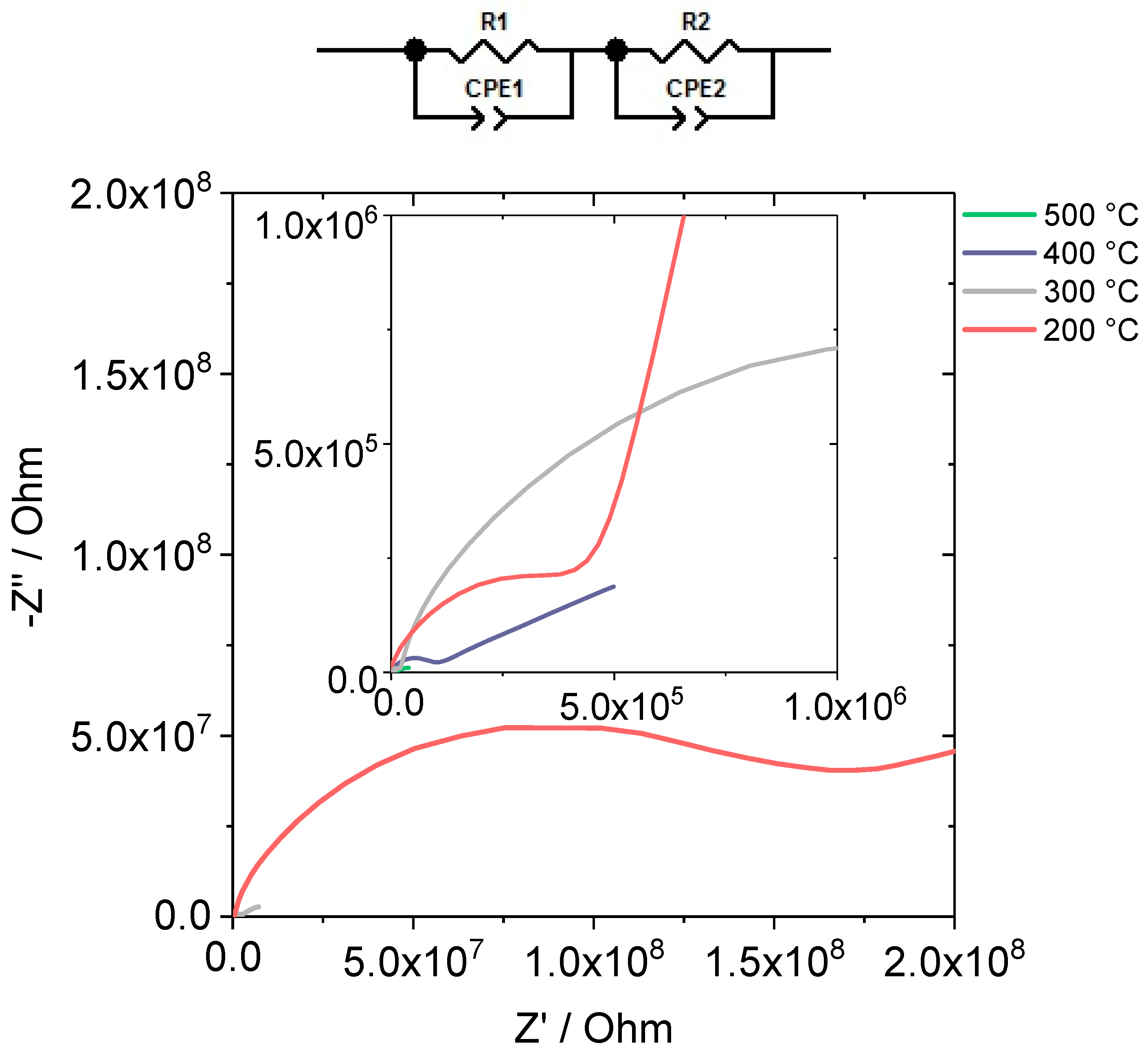
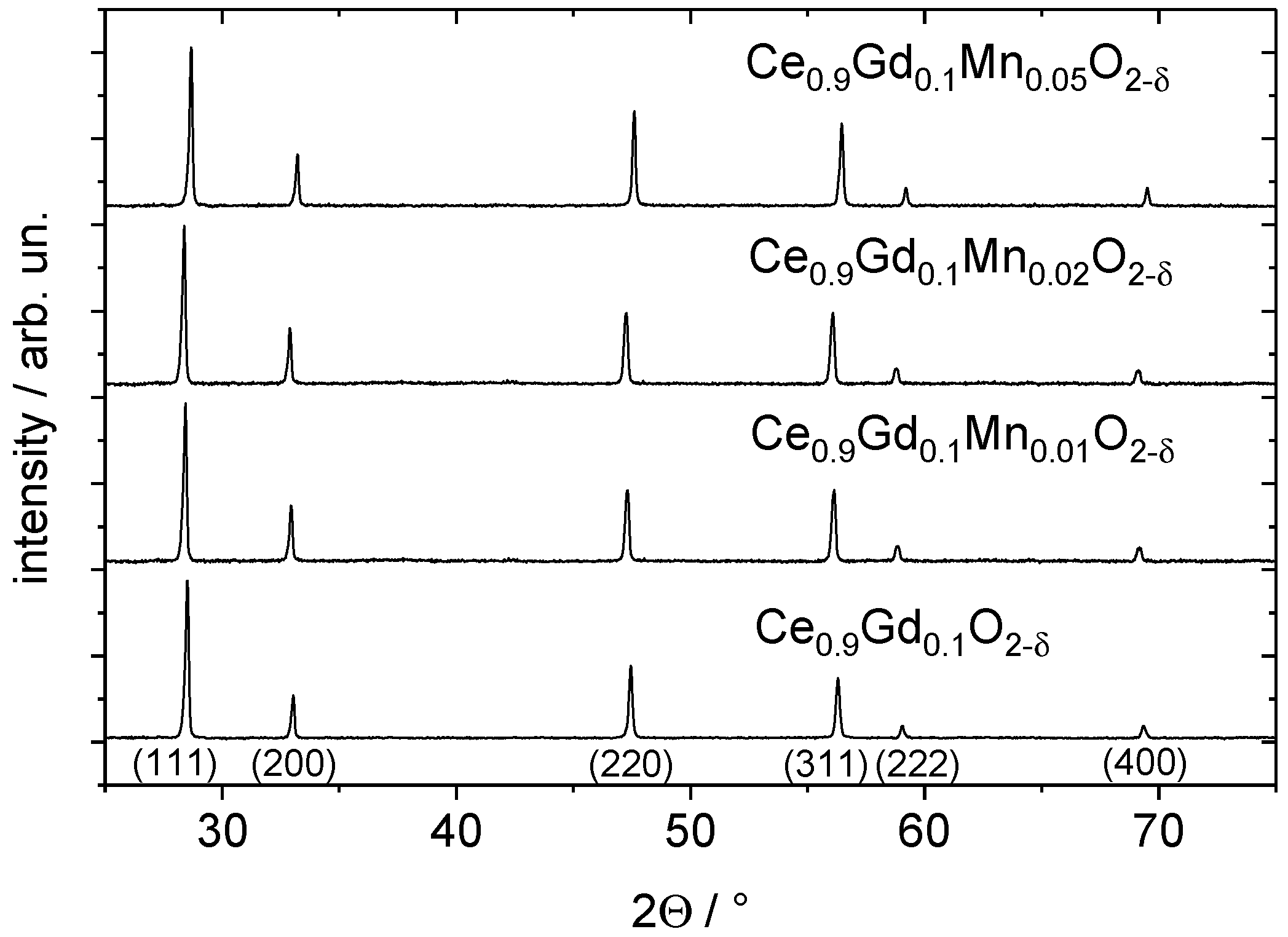

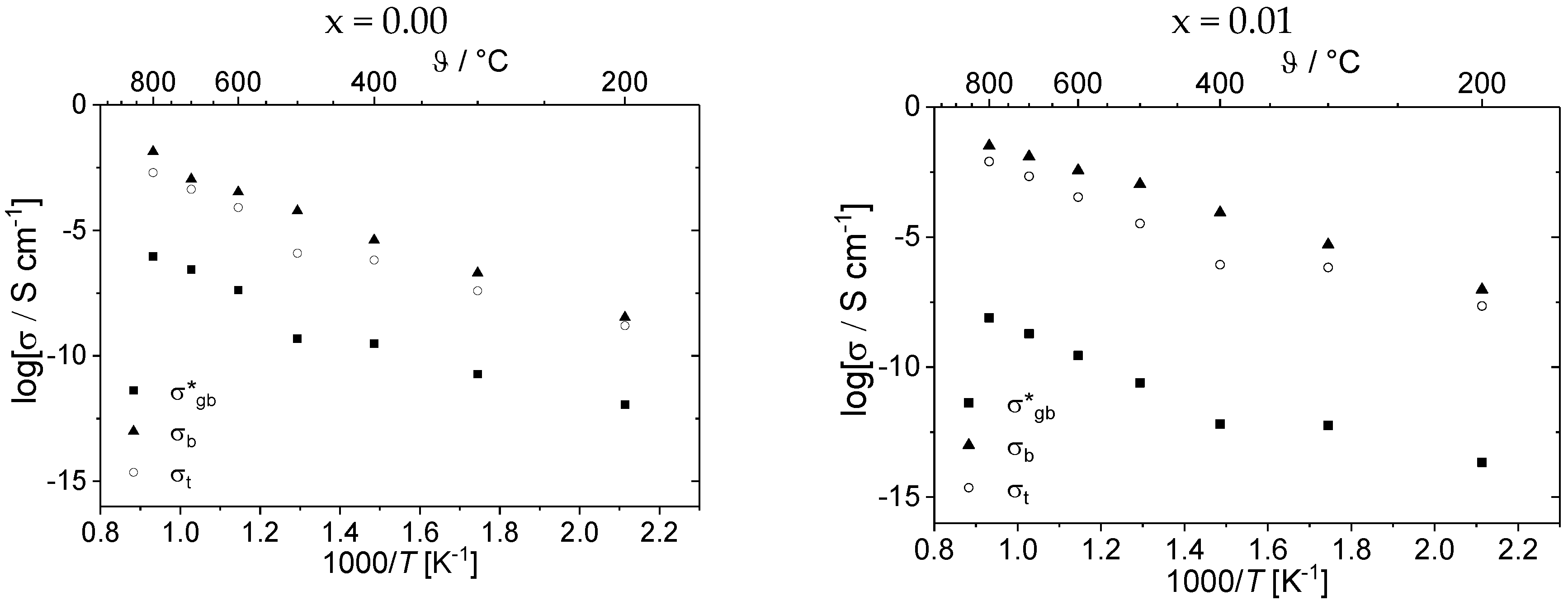
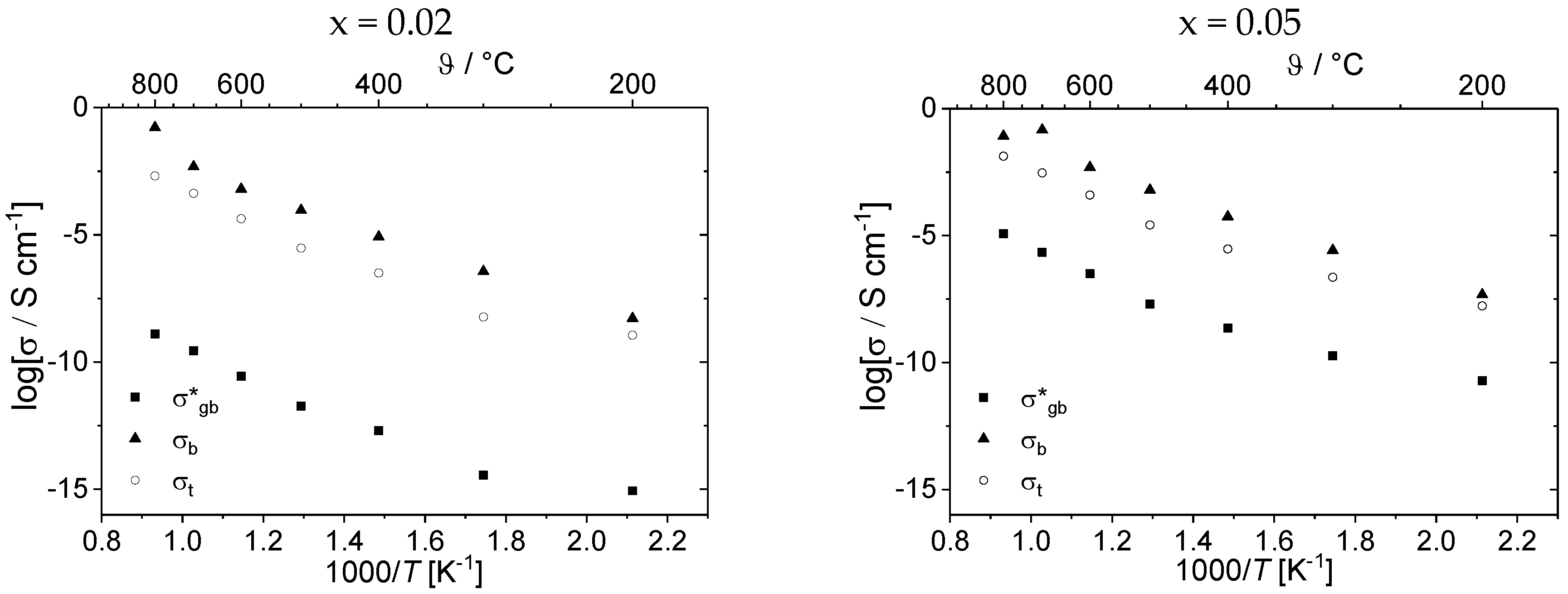
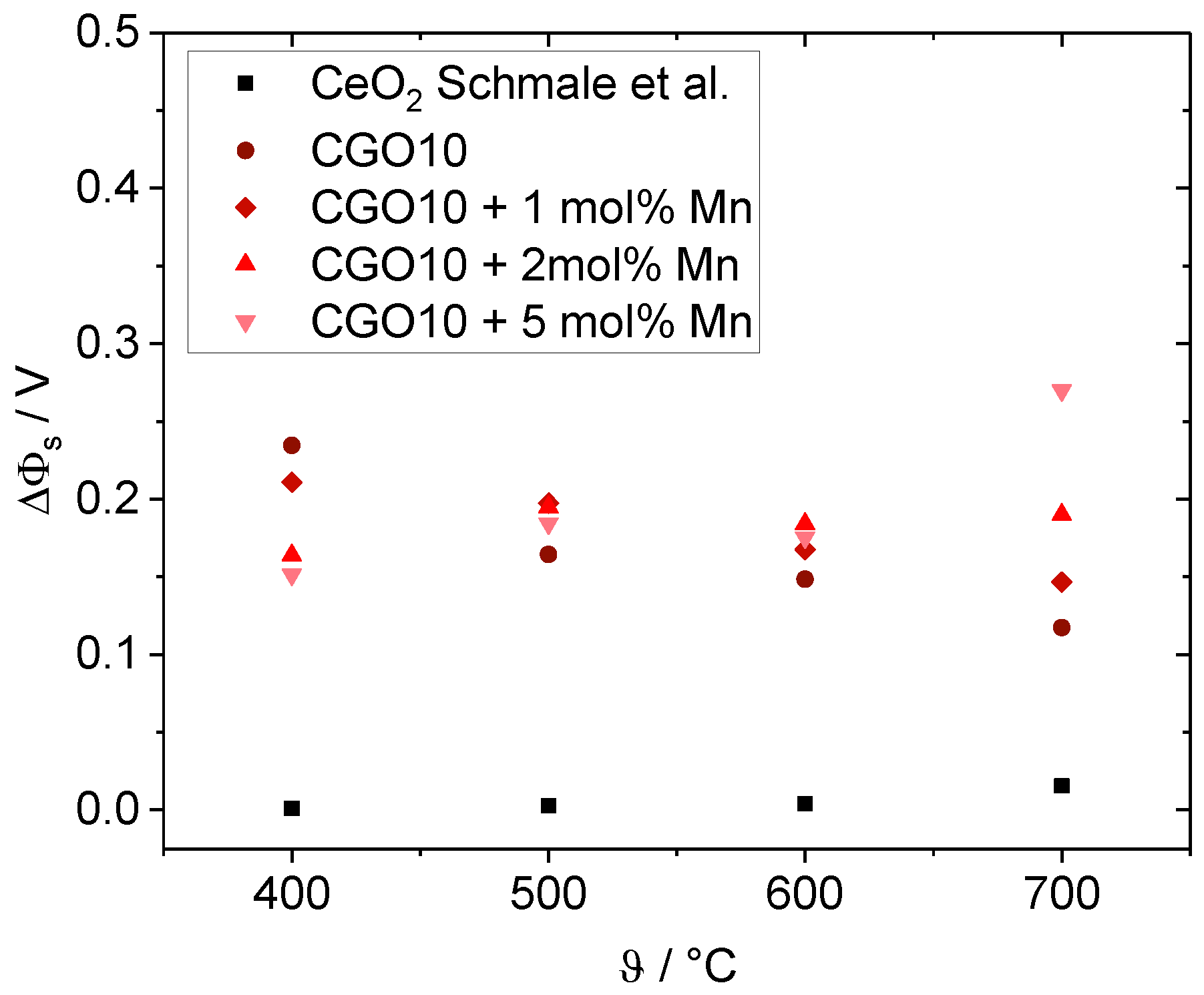
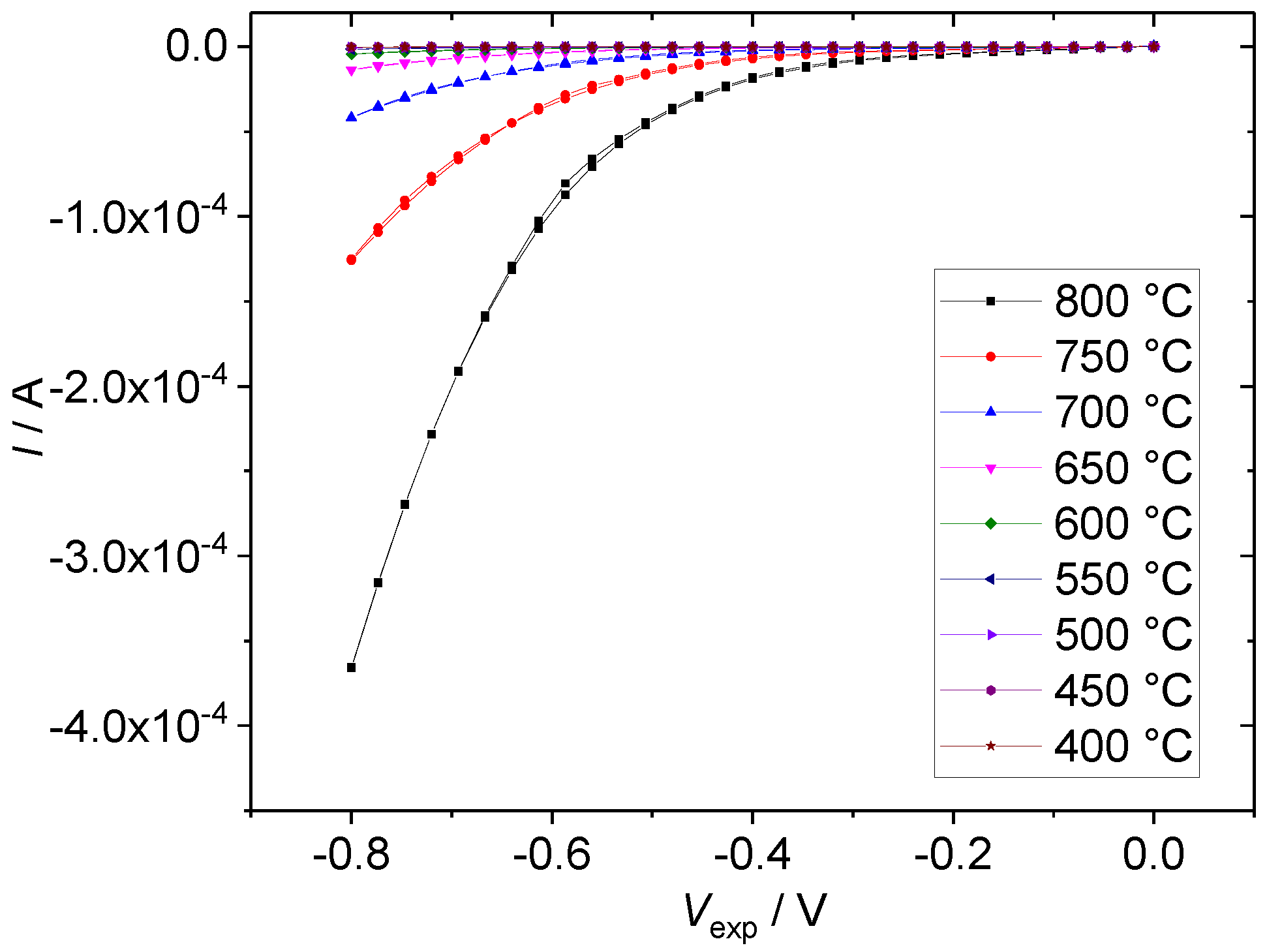
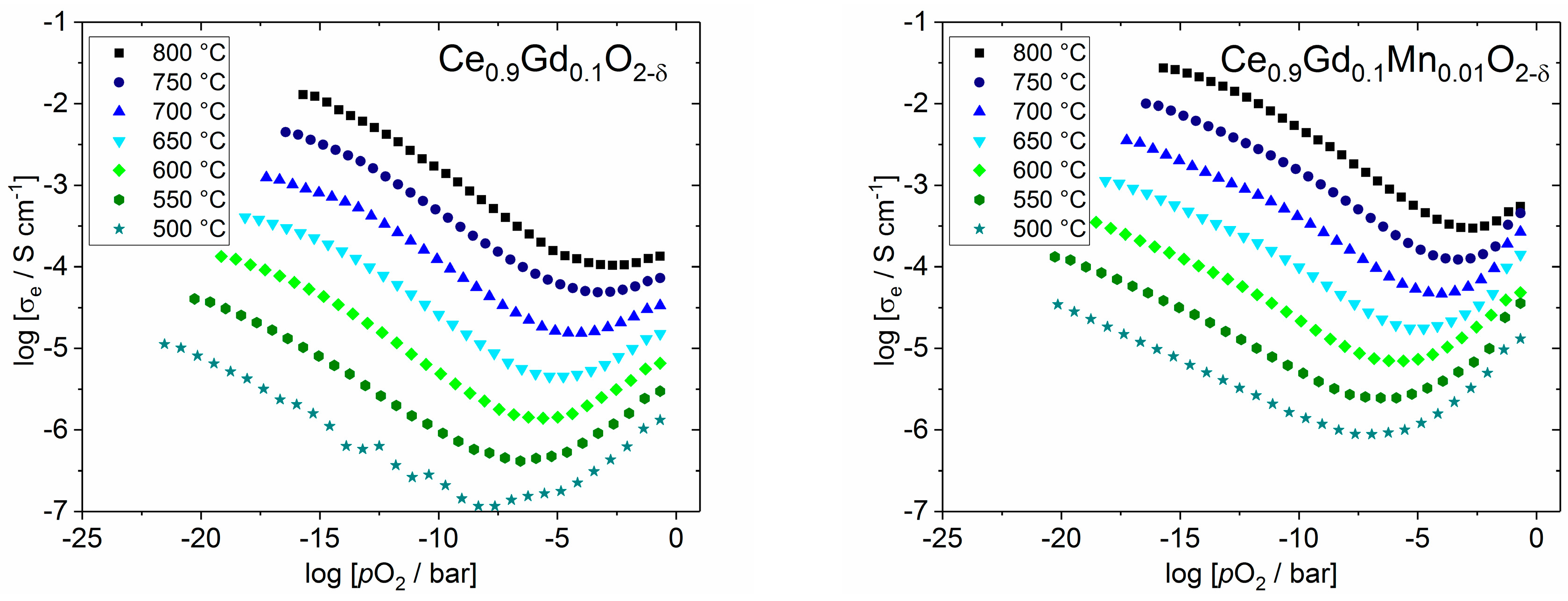
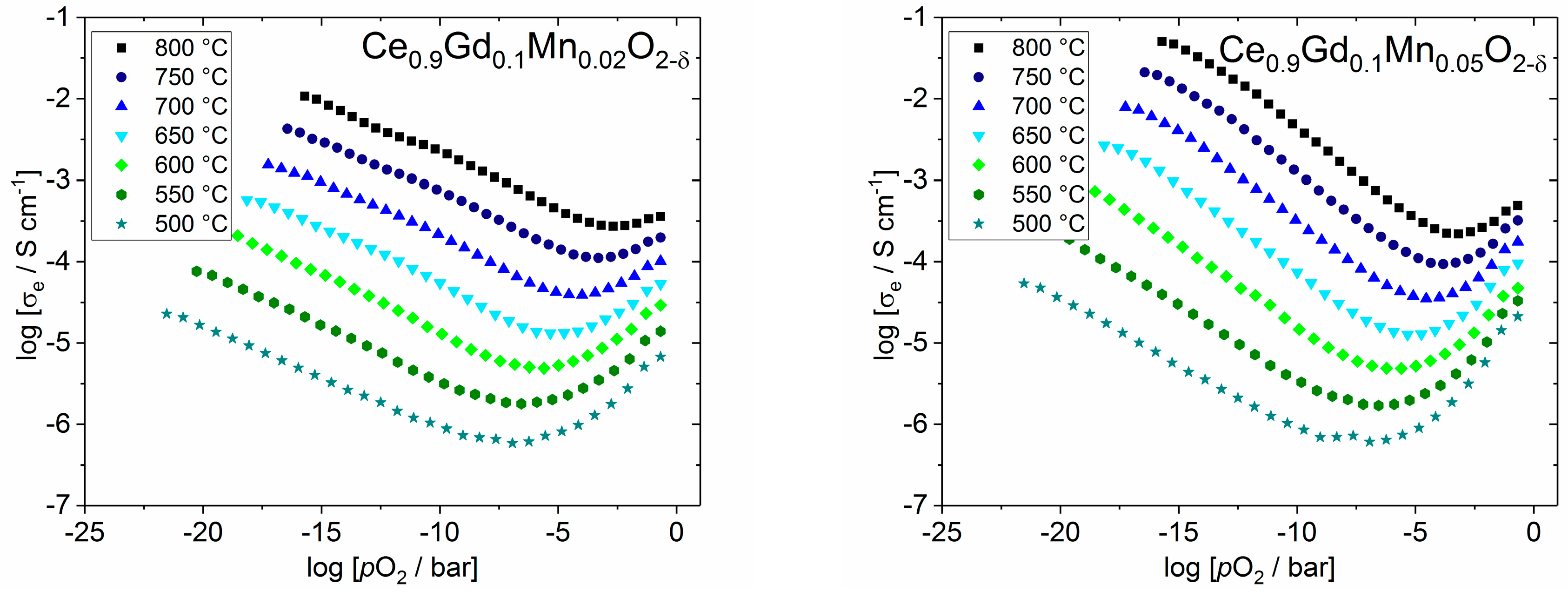
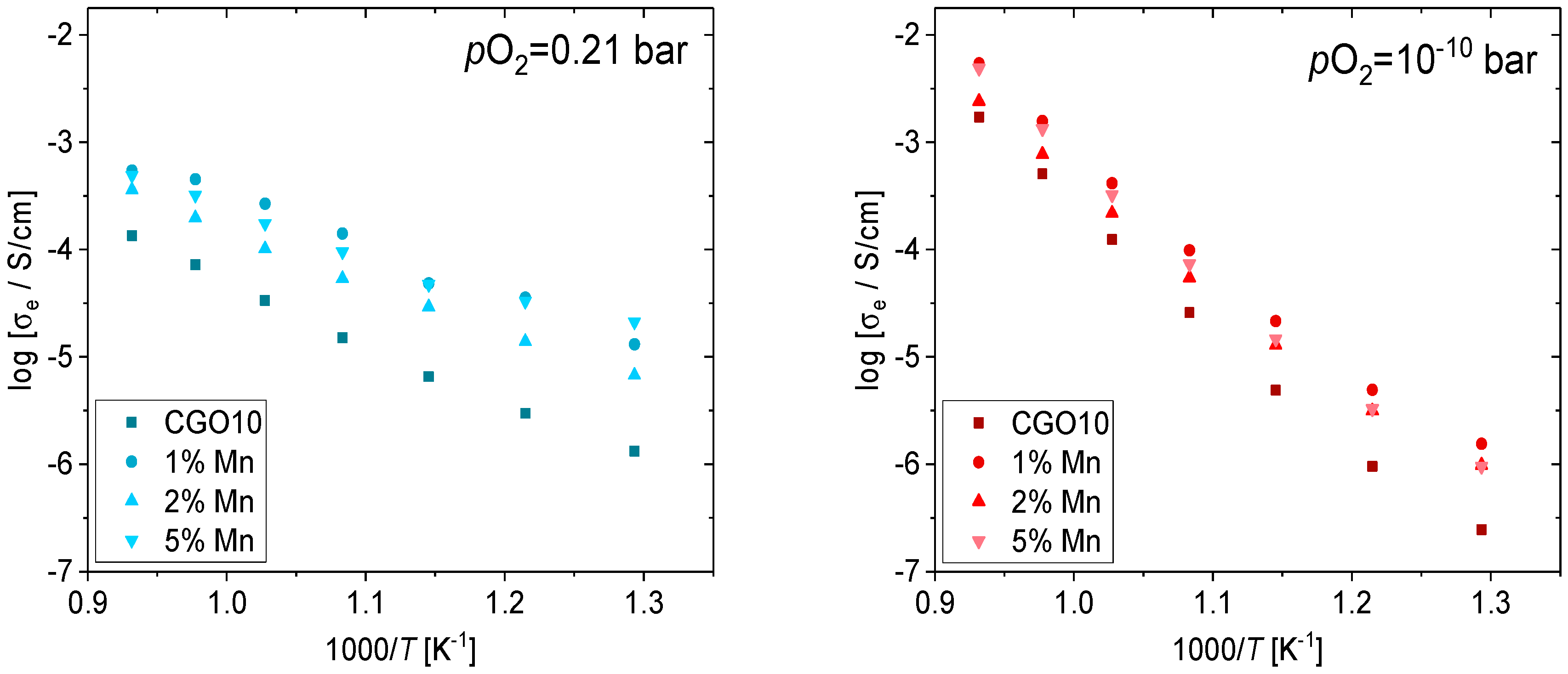
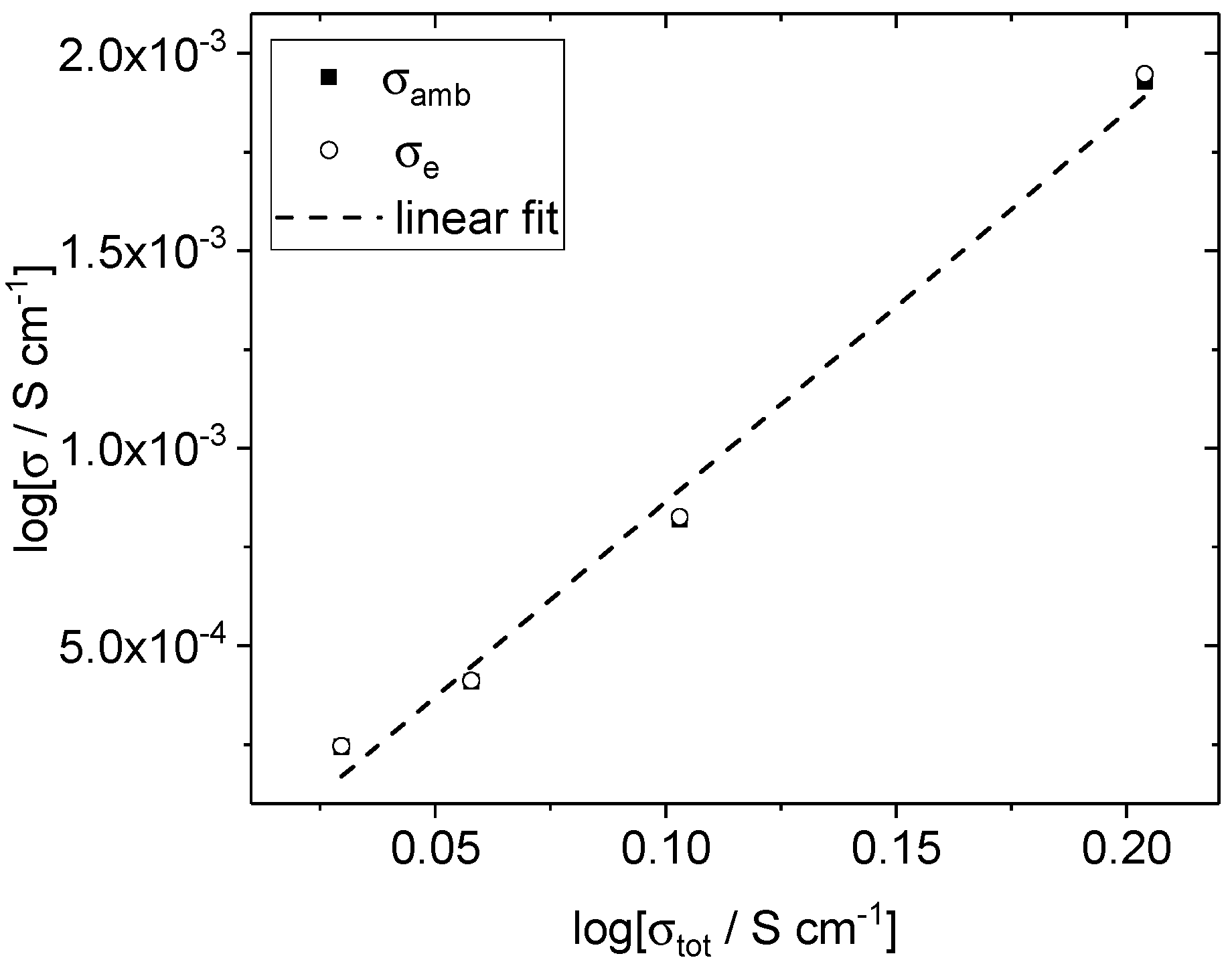
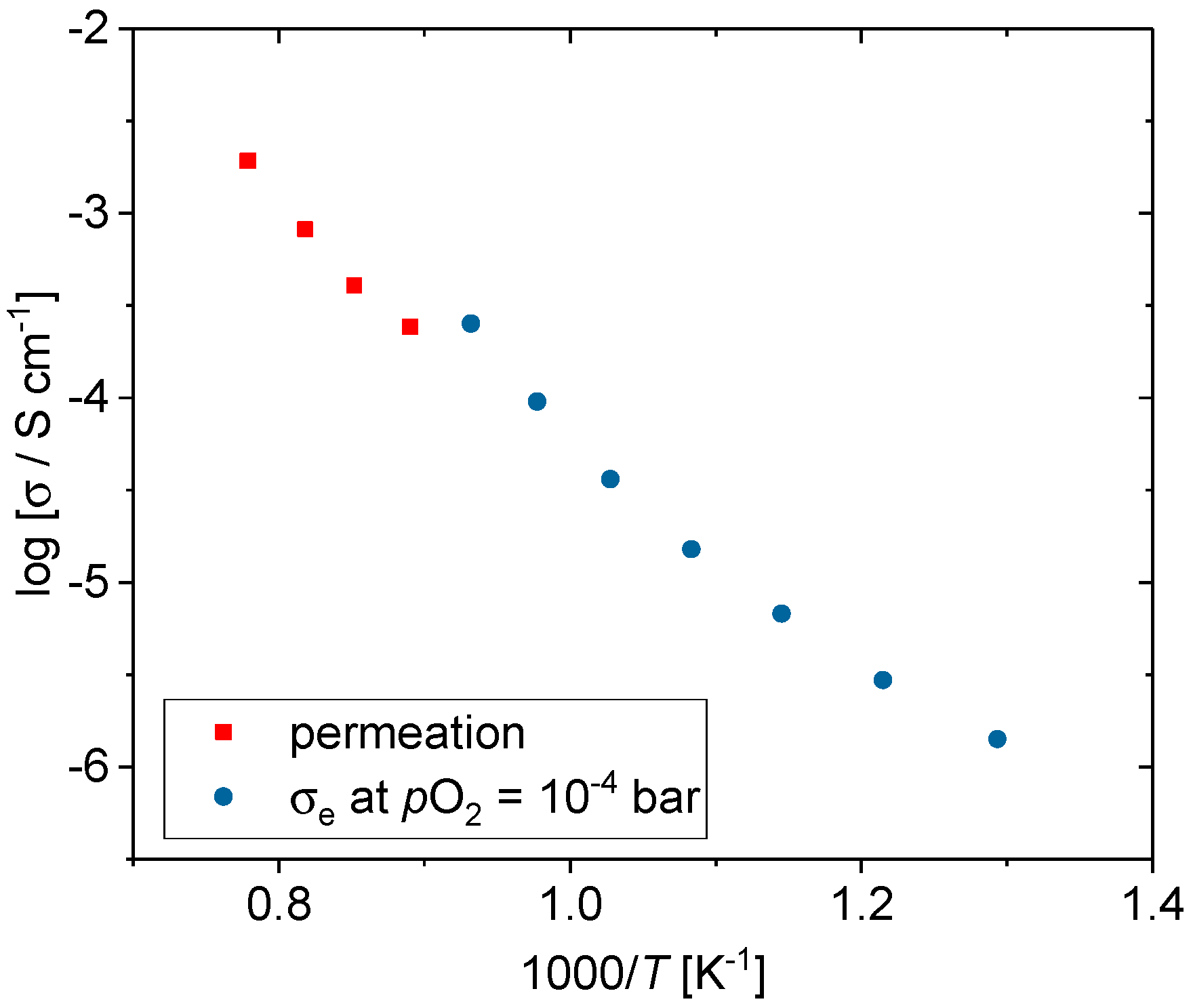
| Composition | Density | Average Grain Size | Lattice Constant/Å |
|---|---|---|---|
| x = 0.00 | 87% | 2.6 ± 1.2 µm | 5.416 |
| x = 0.01 | 92% | 1.2 ± 0.5 µm | 5.432 |
| x = 0.02 | 88% | 1.7 ± 0.7 µm | 5.432 |
| x = 0.05 | 88% | 1.4 ± 0.5 µm | 5.386 |
| Composition | EA,gb/eV | EA,bulk/eV | EA,tot/eV | EA,h/eV | EA,e/eV |
|---|---|---|---|---|---|
| x = 0.00 | 1.45 ± 0.23 | 1.26 ± 0.10 | 1.42 ± 0.21 | 1.20 ± 0.04 | 2.24 ± 0.08 |
| x = 0.01 | 1.51 ± 0.26 | 0.97 ± 0.04 | 1.49 ± 0.05 | 1.00 ± 0.05 | 2.06 ± 0.09 |
| x = 0.02 | 1.47 ± 0.08 | 1.51 ± 0.20 | 1.47 ± 0.08 | 1.02 ± 0.03 | 1.98 ± 0.08 |
| x = 0.05 | 1.43 ± 0.08 | 1.34 ± 0.17 | 1.41 ± 0.07 | 0.85 ± 0.06 | 2.15 ± 0.09 |
| Ce0.79Mn0.01Gd0.2O2−δ [7] | 1.03 | 0.86 | 1.01 | - | - |
| Ce0.985Mn0.005Gd0.01O2−δ [20] | 1.35 ± 0.03 | 0.65 | - | - | - |
| Ce0.9Gd0.1MnxO2−δ | 600 °C | 700 °C | 800 °C | 900 °C | 1000 °C |
|---|---|---|---|---|---|
| x = 0 | 0.41 | 0.17 | 0.07 | - | - |
| x = 0.01 | 0.78 | 0.11 | 0.07 | - | - |
| x = 0.02 | 0.39 | 0.14 | 0.10 | - | - |
| x = 0.05 | 0.45 | 0.11 | 0.04 | 0.007 | 0.010 |
© 2018 by the authors. Licensee MDPI, Basel, Switzerland. This article is an open access article distributed under the terms and conditions of the Creative Commons Attribution (CC BY) license (http://creativecommons.org/licenses/by/4.0/).
Share and Cite
Neuhaus, K.; Baumann, S.; Dolle, R.; Wiemhöfer, H.-D. Effect of MnO2 Concentration on the Conductivity of Ce0.9Gd0.1MnxO2−δ. Crystals 2018, 8, 40. https://doi.org/10.3390/cryst8010040
Neuhaus K, Baumann S, Dolle R, Wiemhöfer H-D. Effect of MnO2 Concentration on the Conductivity of Ce0.9Gd0.1MnxO2−δ. Crystals. 2018; 8(1):40. https://doi.org/10.3390/cryst8010040
Chicago/Turabian StyleNeuhaus, Kerstin, Stefan Baumann, Raimund Dolle, and Hans-Dieter Wiemhöfer. 2018. "Effect of MnO2 Concentration on the Conductivity of Ce0.9Gd0.1MnxO2−δ" Crystals 8, no. 1: 40. https://doi.org/10.3390/cryst8010040
APA StyleNeuhaus, K., Baumann, S., Dolle, R., & Wiemhöfer, H.-D. (2018). Effect of MnO2 Concentration on the Conductivity of Ce0.9Gd0.1MnxO2−δ. Crystals, 8(1), 40. https://doi.org/10.3390/cryst8010040





